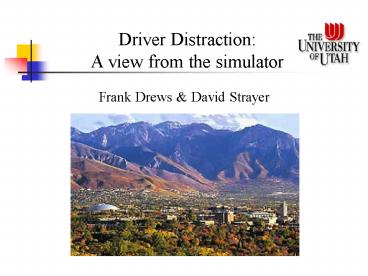Driver Distraction: A view from the simulator - PowerPoint PPT Presentation
1 / 36
Title:
Driver Distraction: A view from the simulator
Description:
Does conversing on a cell phone interfere with driving? ... Eye tracker. Two phases to the study: Phase 1: Single & dual-task driving ... – PowerPoint PPT presentation
Number of Views:249
Avg rating:3.0/5.0
Title: Driver Distraction: A view from the simulator
1
Driver Distraction A view from the simulator
- Frank Drews David Strayer
2
Distracted Driving and Multi-tasking...
3
Research Questions
- Does conversing on a cell phone interfere with
driving? - What are the sources of the interference?
- Peripheral interference (dialing, holding the
phone) - Attentional interference (cell phone
conversation) - Who is affected?
- Are there age / expertise effects?
- How much are drivers affected?
- How significant is the interference?
- How do other cell phone activities compare?
- How do other types of conversation compare?
4
Simulator-Based Studies
5
Does conversing on a cell phone interfere with
driving (Experiment 1)
- Car-following paradigm
- Follow periodically braking pace car
- Required timely and appropriate reactions
- Hands-free cell phone (positioned in advance)
- Naturalistic conversations
- Conditions
- Single vs. dual-task
- Low vs. moderate density
- Measures
- Reaction time
- Following distance
- Rear-end collisions
Single
Dual
Low
Mod.
6
Reaction Time
7
Following Distance
8
Rear-end Collisions
9
Summary (Experiment 1)
- Cell-phone drivers
- Slower reaction times
- Drivers compensate by increasing following
distance - Increase in rear-end accidents
- Cell-phone interference
- Naturalistic conversations
10
Why Do Cell Phones Cause Interference?
- From earlier studies, no interference from
- Radio broadcasts (audio input)
- Books on tape recorded conversations
(audio/verbal input) - Simple shadowing (audio/verbal input, verbal
output) - Implies active engagement in conversation
necessary - Impairments from both hand-held and hands-free
units - Implies central / cognitive locus
- Inattention-blindness (Neisser, Simons)
11
Inattention-Blindness (Experiment 2)
- Is there cell-phone induced inattention
blindness? - Hands-free cell phone
- Naturalistic conversation with confederate
- Eye tracker
- Two phases to the study
- Phase 1 Single dual-task driving
- Phase 2 Recognition memory tests for objects
encountered while driving
12
Recognition Memory Given Fixation
13
Summary (Experiment 2)
- Cell phone conversations create inattention
blindness for traffic related events/scenes - Cell phone drivers look but fail to see up to
half of the information in the driving
environment - No evidence that cell phone drivers protect more
traffic relevant information
14
Are there age / experience effects? (Experiment 3)
- Car-following paradigm
- Follow periodically braking pace car
- Required timely and appropriate reactions
- Hands-free cell phone (positioned in advance)
- Naturalistic conversations
- Performance Measures
- Reaction time
- Recovery time
- Driving speed
- Following distance
Single
Dual
Younger Adults
Older Adults
15
Brake Reaction Time
16
Summary (Experiment 3)
- Main effect of single vs. dual-task
- Reaction time
- Following distance
- Main effect of age
- Slower reactions
- Slower driving speed
- Greater following distance
- No Age x Task interaction
17
How Significant is the Interference?The drunk
driver (Experiment 4)
- Cell-phone vs. drunk-driver
- Redelmeier and Tibshirani (1997) suggested that
the relative risk of being in a traffic
accident while using a cell-phone is similar to
the hazard associated with driving with a blood
alcohol level at the legal limit (p. 465).
18
Cell-phone Driver vs. Drunk Driver
- Car-following paradigm
- Follow periodically braking pace car
- Required timely and appropriate reactions
- Conditions
- Single-task driving
- Cell-phone driving
- Intoxicated driving (BAC 0.08 wt/vol)
- Hands-free Hand-held
19
Reaction Time
20
Following Distance
21
Rear-end Collisions
22
Summary (Experiment 4)
- Compared to drunk drivers, cell-phone drivers
- React slower
- Increase following distance
- Compensate by increasing following distance
- But Still more rear-end accidents
- When controlling for time on task and driving
conditions, cell-phone drivers performance is
worse than that of the drunk driver
23
Other cell phone related activities Text
messaging (Experiment 5)
- Car-following paradigm
- Follow periodically braking pace car
- Required timely and appropriate reactions
- 20 friend dyads
- Conditions
- Single vs. dual-task
- Measures
- Reaction time
- Following distance
- Minimum following distance
- Rear-end collisions
Single
Dual
24
Reaction Time
25
Following Distance
mean min
mean min
26
Rear-end Collisions
27
Summary (Experiment 5)
- Test messaging drivers
- Slower reaction times
- Increased following distance
- But smaller minimum distance
- Increase in rear-end accidents
- Things can be worse Text messaging exceeds cell
phone conversations in accident risk
28
(No Transcript)
29
Other types of conversations Cell Phone vs.
Passenger Conversations (Experiment 6)
- Conditions
- Single task / dual task
- Conversing on cell phone
- Conversing with passenger
- Design
- Task (2) x Condition (2)
30
Cell Phone vs. Passenger Conversations
- Free driving paradigm
- 8 miles of highway
- Exit highway at rest area
- Hands-free cell phone
- Close call stories / friends
- Performance Measures
- Lane keeping
- Navigation task
- Traffic references
31
Lane Keeping Errors
32
Successful Navigation
33
Traffic References
34
Summary (Experiment 6)
- Cell-phone conversations
- More lane keeping errors
- More navigation errors
- Fewer references to traffic
- Passenger conversations
- Collaborative problem solving
- Shared situation awareness
- Passenger actively supports the driver
35
The answers
- Does conversing on a cell phone interfere with
driving? - Yes
- What are the sources of the interference?
- Peripheral interference (dialing)
- Attentional interference (inattention blindness)
- Who is affected?
- Younger and older drivers equally affected
- How significant is the interference?
- Worse than listening to radio/books on tape
- Worse than in-vehicle conversations
- Worse than driving while legally intoxicated
- BUT Less significant than text messaging
36
(No Transcript)































